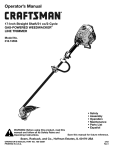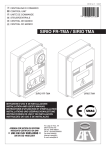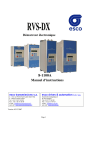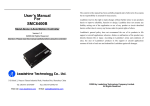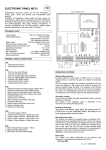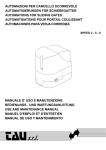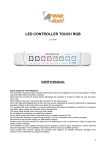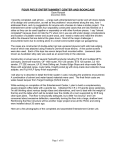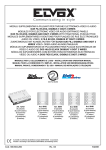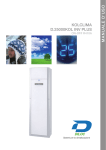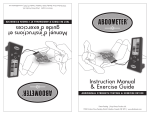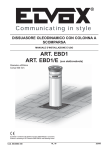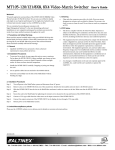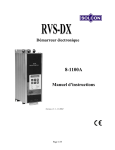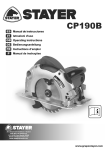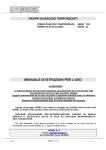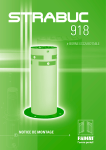Download Manuale d'installazione
Transcript
CENTRALINA ELETTRONICA DI COMANDO PER DIASSUASORI A DISTANZA ELECTRONIC CONTROL UNIT FOR CYLINDRICAL TRAFFIC CONTROL POST CENTRALE ÉLECTRONIQUE POUR BORNE ESCAMOTABLE AUTOMATIQUE CYLINDRIQUE MANUALE D’INSTALLAZIONE E USO INSTALLATION AND OPERATION MANUAL MANUELPOUR LACONNEXION ET L’EMPLOI I GB ART. ECD1 F Il prodotto è conforme alla direttiva europea 2004/108/CE e successive. Product is according to EC Directive 2004/108/CE and following norms. Cod. S6I.ECD.100 RL. 00 2/2009 MISURE DI INGOMBRO ECD1 ECD1 OVERALLDIMENSIONS DIMENSIONS D’ENCOMBREMENT ECD1 2 I 4 3 2 1 12 34 Comune + Alimentazione 230V 50Hz Verde Giallo Rosso GENERALITÀ - FINO A 4 DISSUASORI A SCOMPARSA - APERTURA PEDONALE - PREDISPOSTO PER SEMAFORO A 3 LUCI - AUTOMATICO O SEMIAUTOMATICO - COLLEGAMENTI SEPARATI PER ELETTROVALVOLA - SISTEMA DI SUPERVISIONE INTEGRITA' C.S.I. - PREDISPOSIZIONE PER OROLOGIO ESTERNO - FUNZIONE PASSO-PASSO - UOMO PRESENTE - 20VA 50/60Hz USCITA 24V CC Fusibile Secondario Trasformatore F4= 2A INNESTO PER SEMAFORO A 3 LAMPADE MAX 100W PER LAMPADA TRASFORMATORE - - + 52 53 + T1 M4C TEMPO DI PAUSA 1s - 180s DIP-SWITCH ON Verde 1 2 3 4 5 6 7 8 91011 12 Cond. 20µF M4 Cond. 20µF M3 L12 L13 L14 L15 A OFF B B COMUNE COMUNE COMUNE MOTORE M3 Dissuasore n°3 3 Fusibile Elettrovalvola, Cicalino, Lampeggiatore e Led F5=1A M4 4 MOTORE M4 Dissuasore n°4 FINECORSA CHIUSURA M4 (Colonna alzata) FINECORSA APERTURA M4 (Colonna abbassata) FINECORSA CHIUSURA M3 (Colonna alzata) FINECORSA APERTURA M3 (Colonna abbassata) M3 Cond. 20µF M1 L2 L1 L3 L5 L4 L6 L7 L8 L9 L10 3 4 5 6 7 8 11 12 13 14 15 9 10 B Cond. 20µF M2 A B 16 17 18 19 20 21 N NEUTRO FASE ALIMENTAZIONE QUADRO 230V ±10% 50Hz MONOFASE ALIMENTAZIONE ELETTROVALVOLA 230V 50Hz MOTORE M2 Dissuasore n°2 MOTORE M1 Dissuasore n°1 2 24 25 F M2 M1 1 22 23 COMUNE COMUNE FINECORSA APERTURA M2 (Colonna abbassata) FINECORSA CHIUSURA M2 (Colonna alzata) COMUNE FINECORSA CHIUSURA M1 (Colonna alzata) FINECORSA APERTURA M1 (Colonna abbassata) USCITA 24V 250mA per carico max: - n°2 coppie di fotocellule - n°1 Radio ricevente SPIA 24V 3W max BLOCCO RADIO APRE CHIUDE COMUNE FOTOCELLULE O SPIRA MAGNETICA Morsetto per contatto Passaggio pedonale Motore Dissuasore M1 NUOVE FUNZIONI ECD1 2 Fusibile Motore M1 F1= 5A Filtro antidisturbi A 1 Fusibile Motore M2 F2= 5A L11 Ingresso P 57 58 Fusibile Motore M3 F7= 5A 31 32 33 34 35 36 26 27 28 29 30 (Optional: Schedina Semaforo ad Innesto per lampade a 230V) A Fusibile Motore M4 F6= 5A LAMPEGGIATORE 230V 100W max Gialla M3C M4A T2 TEMPO DI LAVORO 1s - 22s Rossa M3A LED DI SEGNALAZIONE 230V 100W MAX Fusibile 1A 2) 51 COMUNE 63 64 65 66 60 61 1) Fusibile Primario Trasformatore F3= 630mA 55 56 Attenzione: Ogni volta che viene ripristinata l’alimentazione all’ECD1, si devono attendere 10 secondi perchè la logica del programmatore torni a funzionare regolarmente. Diagnostica del finecorsa: Dissuasori EBD2. Con ponticello “STRIP” inserito (come in figura) il ECD1 verifica con un tempo ciclico di 10 minuti se i finecorsa di chiusura (colonna alzata) sono in posizione corretta; se ciò non fosse, vi è un avviamento dal solo motore relativo al dissuasore non in posizione, fino a raggiungimento della corretta posizione di salita. Dissuasori EBD1. È obbligatorio per i dissuasori col solo finecorsa di apertura posizionare il ponticello “STRIP” in posizione libera, come in figura, per avere un corretto funzionamento dell’impianto. 3 La centralina ECD1 di nuova generazione, è utilizzato per il dissuasore a scomparsa serie EBD. Alimentato a 230V monofase, risponde alle normative di sicurezza di Bassa Tensione BT 93/68/CE e Compatibilità Elettromagnetica EMC 93/68/CE, e pertanto si consiglia l'installazione da parte di personale tecnico qualificato secondo le normative di sicurezza vigenti. L'ECD1 si distingue per la capacità di monitorare eventuali guasti o malfunzionamenti dell'impianto (CSI)C.S.I.= Circuito di Supervisione di Integrità, è una particolare funzionalità deli’ECD1 di poter monitorare l'intera scheda elettronica allo scopo di rilevare qualsiasi guasto di un suo componente, o un malfunzionamento di un accessorio dell'impianto, tale per cui se l'automazione è provvista di Elettrovalvola di sblocco, consentel'abbassamento della colonna a scomparsa. La Ditta costruttrice non si assume responsabilità circa l'uso improprio del programmatore; inoltre si riserva di apportare modifiche e aggiornamenti al presente libretto eal programmatore senza preavviso. IMPORTANTE: - Il programmatore deve essere installato in un luogo protetto e asciutto con la propria scatola di protezione - Applicare un Interruttore Magneto - Termico differenziale del tipo 0,03A ad alta sensibilità all'alimentazione del programmatore - Scheda, Motore elettrico, Lampeggiante usare cavi con fili non inferiori a 1,5 mm2 fino a 50m di distanza; per Finecorsa e accessori vari di comando e sicurezza utilizzarecavi con fili da 1mm2 - Per distanze superiori i 50 metri utilizzare fili di sezione idonea alla buona regola di installazione N.B: Per applicazioni quali accensione luci, telecamere, ecc. utilizzare Relè Statici per non creare disturbi al microprocessore. NEL CASO DI MANCATO FUNZIONAMENTO: - Accertarsi che l'alimentazione al programmatore elettronico sia 230V ±10% - Accertarsi che l'alimentazione al Motore Elettrico sia 230V ±10% - Per distanze superiori ai 50 metri aumentare la sezione dei fili. - Controllare la tensione di alimentazione 230V monofase - Controllare i fusibili - Controllare tutti i contatti chiusi del programmatore - Controllare che non ci sia una caduta di tensione tra programmatore e motore elettrico - Se presente l'Elettrovalvola controllare l'integrità di tutti i fusibili LED DI DIAGNOSTICA L1= Apre pedonale, normalmente SPENTO, si illumina a comando Apre Pedonale L2= Fotocellule o Spira, normalmente ACCESO, si spegne con ostacolo presente L3= Apre, normalmente SPENTO, si illumina ad impulso Apre L4= Chiude, normalmente SPENTO, si illumina ad impulso Chiude L5= Blocco, normalmente ACCESO, si spegne ad impulso di Blocco L6= Radio, normalmente SPENTO, si illumina ad impulso Radio L7= Normalmente ACCESO, tensione di rete e integrita' fusibili F1, F2, F3, F4 L8= Finecorsa Apertura M1, normalmente ACCESO, spento a colonna abbassata L9= Finecorsa Chiusura M1, normalmente ACCESO, spento a colonna alzata L10= Finecorsa Apertura M2, normalmente ACCESO, spento a colonna abbassata L11= Finecorsa Chiusura M2, normalmente ACCESO, spento a colonna alzata L12= Finecorsa Apertura M3, normalmente ACCESO, spento a colonna abbassata L13= Finecorsa Chiusura M3, normalmente ACCESO, spento a colonna alzata L14= Finecorsa Apertura M4, normalmente ACCESO, spento a colonna abbassata L15= Finecorsa Chiusura M4, normalmente ACCESO, spento a colonna alzata DIP-SWITCH 1= ON Fotocellula o Spira ferma in apertura 2= ON Radio non inverte in apertura 3= ON Chiude in Automatico 4= ON Prelampeggio Lampeggiatore Attivo 5= ON Radio passo-passo con blocco intermedio 6= ON Servizio un solo Dissuasore Pedonale Motore M1 7= ON Servizio a Uomo Presente 8= Gestione Semaforo (vedere riquadro delle funzioni) 9= Gestione Semaforo (vedere riquadro delle funzioni) 10= ON Lampeggiatore spento in pausa 11= ON Richiude in pausa dopo passaggio fotocellule o spira 12= ON Tempo di lavoro massimo 90s. OFF= 18s 4 ON 1 2 3 4 5 6 7 8 9 10 11 12 OFF COLLEGAMENTI ELETTRICI IN BASSA TENSIONE Fotocellule o Spire Magnetiche: DIP-SWITCH 1: 1 2 9 10 1 CONTATTO PER FOTOCELLULE O SPIRE MAGNETICHE USCITA 24V (CARICO MAX: N°2 COPPIE FOTOCELLULE N°1 RADIO RICEVENTE) DIP-SWITCH 11: 11 Pulsantiera: 3 4 5 ON: Fotocellula o spira ferma in apertura e inverte in chiusura a ostacolo rimosso OFF: Fotocellula o spira non ferma in apertura e inverte in chiusura in presenza di ostacolo ON: Durante la pausa in Automatico (Dip-Switch 3=ON) al passaggio davanti le Fotocellule o Spira chiude dopo 5s OFF: Non chiude al passaggio davanti le Fotocellule 6 NA NA NC CHIUDE BLOCCO APRE COMUNE Contatto Radio: 3 DIP-SWITCH 2: 7 ON: Non inverte in apertura - Apre/Chiude (normale) - Inversione di marcia ad ogni impulso - Passo Passo 2 CONTATTO RADIO COMUNE OFF: Inverte la marcia ad ogni impulso DIP-SWITCH 5: ON: Passo passo con blocco intermedio 5 OFF: Funzionamento normale Spia 24V 3W di Segnalazione del movimento: Spia Accesa = Colonna abbassata, passaggio libero Spia Spenta = Colonna alzata, passaggio chiuso Lampeggia a 0,5s (veloce) = movimento di salita Lampeggia a 1s (normale) = movimento di discesa Con orologio esterno: 2 brevi lampeggi seguito da una pausa più lunga 8 COMUNE Uscita 24V CC: 3 + - Uscita per una eventuale utenza a 24V CC 200mA per accessori 55 56 COLLEGAMENTI ELETTRICI DI POTENZA Motori: Condensatore Importante: Durante il cablaggio è conve- aggiuntivo in mancanza di spunto per niente collegare un solo motore con i relativi finecorsa Motore M1 da 20µF ed eseguire la "messa infase" di un dissuasore per volta A T2 TEMPO DI PAUSA 1s - 180s 19 20 21 A B 31 32 33 Condensatore aggiuntivo in mancanza di spunto per Motore M4 da 20µF A B 34 35 36 COMUNE DIP-SWITCH 12: + B Condensatore aggiuntivo in mancanza di spunto per Motore M3 da 20µF COMUNE T1 TEMPO DI LAVORO 1s - 22s 16 17 18 - A COMUNE + COMUNE - B Condensatore aggiuntivo in mancanza di spunto per Motore M2 da 20µF M1 M2 M3 M4 MOTORE M1 Dissuasore n°1 MOTORE M2 Dissuasore n°2 MOTORE M3 Dissuasore n°3 MOTORE M4 Dissuasore n°4 ON: Tempo di lavoro massimo 90s 12 OFF: Tempo di lavoro massimo 18s 5 Finecorsa: 11 12 13 14 15 26 27 28 29 30 FINECORSA CHIUSURA M4 (Colonna alzata) COMUNE FINECORSA FINECORSA APERTURA M4 (Colonna abbassata) FINECORSA CHIUSURA M3 (Colonna alzata) FINECORSA APERTURA M3 (Colonna abbassata) FINECORSA CHIUSURA M2 (Colonna alzata) COMUNE FINECORSA FINECORSA APERTURA M2 (Colonna abbassata) IMPORTANTE: Per Dissuasori con un solo finecorsa,ponticellare gli ingressi finecorsa di chiusura 12 e 15 non utilizzati con il comune13 e gli ingressi 27 e 30 non utilizzati con il comune 28 FINECORSA CHIUSURA M1 (Colonna alzata) FINECORSA APERTURA M1 (Colonna abbassata) Non è necessario ponticellare gli ingressi dei finecorsa dei dissuasori non presenti nell'installazione Alimentazione Elettrovalvola: 22 Con Elettrovalvola collegata, a mancata alimentazioneelettrica del quadro, oppure in situazione dimalfunzionamento del programmatore, o in presenza di unfusibile bruciato, la colonna si abbassa automaticamente. 25 DIP-SWITCH 4 e 10: 53 COMUNE Si possono collegare sia il Lampeggiante esterno sia i Led a luceintermittente funzionanti solo durante il movimento di salita ediscesa. Il cavo da collegare è quello segnato come cavolampeggiatore 52 24 ALIMENTAZIONE ELETTROVALVOLA 230V 50Hz Lampeggiante esterno: 51 23 ON:Prelampeggio 4 OFF: Senza prelampeggio 230V 100W MAX ON: Lampeggiatore Disattivatodurante la pausa in automatico 10 OFF: Lampeggia durante la pausain automatico Led di segnalazione: 51 53 MARRONE USCITA LED DI SEGNALAZIONE 230V 100W MAX 51 52 53 NERO COMUNE Cicalino di movimento (accessorio optional): Collegando il filo Blu-Comune e il filo Nero del cavo"lampeggiante" si attiva il segnale sonoro di movimento disalita e discesa all'interno della colonna a scomparsa 52 COMUNE Uscita per Led a luce intermittente sempre funzionanti duranteil movimento di salita e discesa e nella sosta a colonna alzata. Si spengono a colonna abbassata Collegare il filo Blu-Comune e il filo Marrone del cavo lampeggiatore del dissuasore. USCITA PER CICALINO DI MOVIMENTO 230V 100W MAX Alimentazione quadro: Alimentazione scheda programmatore. 22 23 24 FASE N NEUTRO F 25 ALIMENTAZIONE QUADRO 230V ±10% 50Hz MONOFASE FUNZIONI Automatico / Semiautomatico: Ciclo Automatico: ad un impulso di comando apre, la colonna si abbassa, si ferma in Pausa per il tempoimpostato sul trimmer T2, scaduto il quale richiude automaticamente Ciclo Semiautomatico: ad un impulso di comando apre la colonna si abbassa. Per Chiudere il passaggiobisogna dare l’impulso di chiusura. 6 DIP-SWITCH 3: - + T2 Tempo di Pausa da 1 a 180s ON= Chiude in Automatico 3 OFF=Non chiude in Automatico Funzione Semiautomatico Apertura Pedonale: Comando separato dal comando di aperturanormale. Quando tutti i dissuasori hanno lacolonna alzata, ad impulso di ingresso P, con DipSwitch 6= On e 3=On, si abbassa la colonnadel dissuasore n°1 (Motore M1) per passaggiopedonale del tempo di pausa impostato sulTrimmer T2, scaduto il quale richiudeautomaticamente. Ingresso P DIP-SWITCH 3 - 6 entrambi in ON DIPON= Chiude in Automatico OFF= Non chiude in Automatico Funzione Semiautomatico 57 58 3 Morsetto per contatto Passaggio pedonale Motore Dissuasore M1 - ON= Apertura Pedonale Motore M1 6 OFF= Funzionamento normale + T2 Tempo di Pausa da 1 a 180s Uomo Presente: Si ottiene il comando di apertura e chiusura "ad azione mantenuta" (senza autotenuta nei Relè), quindi l'attiva presenza dell'operatore durante tuttoil movimento dell'automazione fino al rilascio del pulsante o della chiavedel selettore M1 M3 M2 M4 DIP-SWITCH 7 ON= Funzionamento a Uomo Presente 7 OFF= Funzionamento Normale Orologio esterno Orologio Esterno (Optional): 3 - + 4 NA COMUNE APRE T2 Tempo di Pausa da 1 a 180s COMUNE OROLOGIO: La centralina elettronica ECD1 consente il collegamento di un normale orologio orario per l'apertura-chiusuradel dissuasore. Collegamento: collegare in parallelo il contatto NA dell'Orologio con il morsetto n°4 APRE e n°3 COMUNE, attivando larichiusura automatica con il Dip-Switch n°3=ON Funzionamento: programmare l'orario di apertura sull'orologio, all'ora impostata il dissuasore si abbassa rimanendo aperto(il lampeggiante si spegne e la spia segnala con 2 brevi lampeggi seguito da una pausa più lunga), e non accetterà piùnessun comando (anche radio) sino allo scadere del tempo impostato sull'orologio, allo scadere del quale dopo il tempodi pausa seguirà la salita automatica. DIP-SWITCH N°3 = ON Chiusura Automatica 3 ON= Chiude in Automatico OFF= Non chiude in Automatico Funzione Semiautomatico OFF 8 OFF 9 ON OFF 8 9 Dip-Switch 8=OFF e 9=ON Si accende il Giallo per tempo 6s poi si accende il Rosso edopo 5s si alza la colonna ON Dip-Switch 8=ON e 9=ON Si accende il Giallo per tempo 10s poi si accende il Rosso edopo 7s si alza la colonna 9 ON 8 9 Dip-Switch 8=ON e 9=OFF Si accende il Giallo per tempo 2s poi si accende il Rosso edopo 2s si alza la colonna ON OFF 8 Dip-Switch 8=OFF e 9=OFF Si accende il Giallo per tempo 0s e dopo 0s si accende il Rosso esi alza la colonna immediatamente Comune Alimentazione 230V 50Hz Giallo DIP-SWITCH 8 e 9 Verde Alimentazione della schedina è indipendente da quella della scheda del programmatore:230V 50Hz con uscita di 100W a 230V per lampada.Funzionamento anche per Semaforo a 2 lampade Rosso e Verde (Dip Switch 8=OFF e 9=OFF) Logica di Funzionamento: - Luce VERDE= Colonna abbassata, passaggio APERTO - Luce ROSSA= Colonna in movimento o alzata, passaggio CHIUSO - Luce GIALLA= interviene prima del passaggio da luce Verde a luce Rossa Nota: In funzionamento Pedonale il Semaforo rimane sempre ROSSO. Rosso Schedina Semaforo ad Innesto (Optional): ROSSO 63 64 65 66 60 61 GIALLO Fusibile 1A Rossa VERDE Gialla Verde (Optional: Schedina Semaforo ad Innesto perlampade a 230V) 7 GB 4 3 2 1 12 34 + Power supply 230V 50Hz Green Yellow Red Common GENERAL INSTRUCTIONS - UP TO 4 BOLLARDS - STEP-BY-STEP FUNCTION - PEDESTRIAN OPENING - PREPARED FOR 3 LAMPS TRAFFIC LIGHTS - AUTOMATIC OR SEMI- AUTOMATIC - SEPARATE CONNECTIONS FOR ELECTRIC VALVE - TIME CLOCK EXTERNAL - DEAD MAN CONTROL - ISC SYSTEM i.e. INTEGRITY SUPERVISION - 20VA 50/60Hz Primary fuse transformer F3= 630mA 55 56 Secondary fuse transformer F4= 2A 24V DC output PLUG-IN CONNECTOR FOR 3LAMP TRAFFIC LIGHTS MAX 100W EACH LAMP 51 TRANSFORMER - - + + T1 M4C DWELL TIME 1s - 180s DIP-SWITCH ON Green 1 2 3 4 5 6 7 8 91011 12 Cond. 20µF M4 Cond. 20µF M3 L12 L13 L14 L15 A OFF B B COMMON COMMON COMMON 4 MOTOR M4 Bollard n°4 MOTOR M3 Bollard n°3 LIMIT SWITCH CLOSE M4 (Bollard in up position) LIMIT SWITCH OPEN M4 (Bollard in down position) LIMIT SWITCH CLOSE M3 (Bollard in up position) LIMIT SWITCH OPEN M3 (Bollard in down position) 3 Electric valve fuse, Acoustic device, Flashing light and Led F5=1A M4 M3 L2 L3 L5 L4 L6 L7 L8 L9 L10 Anti-disturbance filter A 1 2 3 4 5 6 7 8 B A B 16 17 18 19 20 21 11 12 13 14 15 9 10 Motor fuse M1 F1= 5A L11 Input P 57 58 Motor fuse M2 F2= 5A Capacitor 20µF M2 Capacitor 20µF M1 L1 Fusle Motor M3 F7= 5A 31 32 33 34 35 36 26 27 28 29 30 (Optional: Plug-in PCB for traffic light to suit 230 V lamp) A Fuse Motore M4 F6= 5A FLASHING LIGHT 230V 100W max Yellow M3C M4A T2 MOTOR RUN TIME 1s - 22s Red M3A SIGNAL LIGHT 230V 100W MAX Fuse 1A F LIVE NEUTRAL POWER SUPPLY 230V ±10% 50Hz SINGLE- PHASE MOTOR M2 Bollard n°2 MOTOR M1 Bollard n°1 ELECTRIC VALVE POWER SUPPLY 230V 50Hz M2 2 24 25 N COMMON COMMON LIMIT SWITCH OPEN M2 (Bollard in down position) LIMIT SWITCH CLOSE M2 (Bollard in up position) COMMON LIMIT SWITCH CLOSE M1 (Bollard in up position) LIMIT SWITCH OPEN M1 (Bollard in down position) OUTPUT 24V for max charge n°2 pairs of photocells n°1 Radio receiver LED 24V 3W max STOP RADIO CLOSE OPEN COMMON PHOTOCELLS OR MAGNETIC LOOP Pedestrian opening connection Motor Bollard M1 M1 1 22 23 NEW FUNCTION ECD1 Note well: Whenever ECD1 is re-powered, wait 10 seconds for the logic to become fully operating again Limit switch diagnostic: EBD2 of ballards. When the “STRIP” jumper inserted (as in the picture), ECD1 checks cyclical every 10 minutes that the closing limit switches (post raised) are in the correct position; should any of them fail to be such, only the motor of the post not in position is operated until this is fully up as required. 8 53 COMMON 63 64 65 66 60 61 1) 2) 52 EBD1 of ballards. For the pasts that are fitted only with the opening limit switch, position the “STRIP” jumper as in the picture to achieve a correct performance of the system. The electronic control panel ECD1, new generation, is designed to operate the EBD. Power supply is 230V single-phase. Built in full compliance with BT 93/68/CE Low/High Voltage and EMC 93/68/CE ElectroMagnetic Compatibility Regulations. Fitting operations are recommended by a qualified technician in conformity tothe existing safety standards.ECD1 is capable of monitoring damages or malfunctioning with the system (ISC). I.S.C.= Integrity and Supervision Circuit, is a special function of ECD1 which can self control the electronic PCB and detect any damages occurring with any componentsor accessories. In this case, provided that the post is fitted with a release electric valve, lowering is allowed automatically. The manufacturing company declines any responsability for incorrect handling and application; also, it reserves the right to change or update the control panel any time PLEASE NOTE: - The control panel must be installed in a sheltered, dry place, inside the box provided with it. - Fit the mains to the control panel with a 0.03A high performance circuit breaker. - Use 1.5mm2 section wires for voltage supply, electric motor and flashing lamp. Maximum recommended distance 50m. - Use 1mm2 section wires for limit switches, photocells, push-buttons/key- switch and accessories. N.W: To fit extra accessories such as lights, CCTV etc. use only solid state relays to prevent damages to the microprocessor. IN CASE OF FAILURE OF THE PANEL: - Check the electronic PCB voltage supply is 230V - Check the electric motor power supply is 230 V - Check fuses - Check photocells if contacts are normally closed - Check all NC contacts - Check that no voltage drop has occurred from the control board to the electric motor - Check all the status indication leds- In case the electric valve is fitted, check integrity with all fuses. LED STATUS INDICATION L1= Pedestrian opening, normally OFF, alight when a pedestrian open pulse is given L2= Photocells or loop, normally ALIGHT, if obstructed light goes off L3= Open, normally OFF, alight when an open pulse is given L4= Close, normally OFF, alight when a close pulse is given L5= Stop, normally ON, it goes off when a stop pulse is given L6= Radio, normally OFF, alight when a Radio pulse is given L7= Normally ON, mains voltage and fuse integrity F1, F2, F3, F4 L8= Limit switch open M1, normally ON, it goes off when the post is in down position L9= Limit switch close M1, normally ON, it goes off when the post is in up position L10= Limit switch open M2, normally ON, it goes off when the post is in down position L11= Limit switch close M2, normally ON, it goes off when the post is in up position L12= Limit switch open M3, normally ON, it goes off when the post is in down position L13= Limit switch close M3, normally ON, it goes off when the post is in up position L14= Limit switch open M4, normally ON, it goes off when the post is in down position L15= Limit switch close M4, normally ON, it goes off when the post is in up position DIP-SWITCH 1= ON Photocells or loop stop while opening 2= ON Radio no reversing while opening 3= ON Automatic closing 4= ON Pre flashing activated 5= ON Radio step by step stop in between 6= ON Pedestrian opening Motor M1only one post operating 7= ON Dead man control 8= Traffic lights (see functions) 9= Traffic lights (see functions) 10= ON No lamp on during dwell time 11= ON Close on dwell time after passage through photocells or over the loop 12= ON Max working time 90s. OFF= 18s ON 1 2 3 4 5 6 7 8 9 10 11 12 OFF 9 LOW VOLTAGE ELECTRICAL CONNECTIONS Photocells or Loop Detectors: DIP-SWITCH 1: 1 2 ON: Photocells or loop stop while opening,reverse on closing once obstacle is removed OFF: Photocells or loop do not stop whileopening, reverse on closing in caseof an obstacle 9 10 1 CONTATTO PER PHOTOCELLS FOTOCELLULE OR LOOPO SPIRE MAGNETICHE DETECTORS 24V24V OUTPUT USCITA (CARICO MAX: N°2 (MAX. COPPIE LOAD: FOTOCELLULE N°1 RADIO RICEVENTE) 2 PAIRS PHOTOCELLS DIP-SWITCH 11: ON: During dwell time, Automatic mode(Dip-Switch 3=ON) after engaging the photocellsor loop, it closes 5s later OFF: It does not close after engaging the photocells or loop 1 RADIO RECEIVER) 11 Key switch: 3 4 5 6 NA NA NC BLOCCO STOP CHIUDE CLOSE APRE OPEN COMMON C OMUNE Contatto Radio: 3 DIP-SWITCH 2: 7 ON: It does not reverse on opening - Apre/Chiude (normale) - Inversione di marcia ad ogni impulso - Passo Passo 2 OFF: It reverses at any pulse CONTACT CRADIOONTATTO RADIO CCOMMON OMUNE DIP-SWITCH 5: ON: Step by step with stop in between 5 OFF: Standard operation 24V 3W Movement Indication Light Light ON = Post in down position, free passage Light OFF = Post in up position, closed passage Flashing 0,5s (fast)= rising post Flashing 1s (normally)= lowering post With external clock: 2 short flashes followed by a longer pause 3 COMUNE COMMON 24V DC Output: 8 + 200mA foraccessori accessories 200mA per Output for 24V D.C. applications 55 56 ELECTRICAL POWER CONNECTIONS Motors: Important: when doing the electric powerconnections it is better to connect only onemotor and its respective limit switches. Putthe posts into phase one by one. 20µF additional capacitor in case of power shortage for Motor M1 A B 16 17 18 DIP-SWITCH 12: ON: Motor run time max 90s 12 OFF: Motor run time max 18s 10 19 20 21 M1 MOTOR M1 MOTORE M1 Post n°1 n°1 Dissuasore A B 31 32 33 M2 MOTOR M2 MOTORE M2 Dissuasore Post n°2 n°2 20µF additional capacitor in case of power shortage for Motor M4 A B 34 35 36 COMMON C OMUNE T2 DWELL TIME TEMPO DI PAUSA 1s --180s 1s 180s B 20µF additional capacitor in case of power shortage for Motor M3 COMMON COMUNE T1 MOTOR RUN TEMPO DI LAVORO TIME - 22s 1s 1s - 22s + A COMMON COMUNE - + COMMON COMUNE - 20µF additional capacitor in case of power shortage for Motor M2 M3 MOTORE M3 MOTOR M3 Dissuasore Post n°3 n°3 M4 MOTOR M4 MOTORE M4 Post n°4 n°4 Dissuasore Limit switch: 11 12 13 14 15 26 27 28 29 30 COMMON LIMIT SWITCH LIMIT SWITCH CLOSE M4 (Post in up position) LIMIT SWITCH OPEN M4 (Post in down position) 25 LIMIT SWITCH CLOSE M3 (Post in up position) LIMIT SWITCH CLOSE M2 (Post in up position) 24 LIMIT SWITCH OPEN M3 (Post in down position) LIMIT SWITCH OPEN M2 (Post in down position) COMMON LIMIT SWITCH IMPORTANT: For posts with only one limitswitch, bridge the closing limit switches inputs 12 and 15 (which are not used) with the common 13 and the inputs 27 and 30 (which are not used) with the common 28. LIMIT SWITCH CLOSE M1 (Post in up position) LIMIT SWITCH OPEN M1 (Post in down position) There is no need to bridge the limit switch inputs of theposts which are not present in the installation Electric valve power supply: 22 In case of power failure, electronic programmer malfunctionning, or a burnt fuse, should an electric valve be installed, the bollard lowers automatically 23 ELECTRIC VALVE POWER SUPPLY 230V 50Hz External flashing light: 52 53 ON: Pre-flashing COMMON It is possible to connect both the external Flashing light and theintermittent signal lights which are on only during the rising andlowering movement. The cable for the connection is the onelabelled as flashing lights cable DIP-SWITCH 4 and 10: 51 4 230V 100W MAX OFF: No pre-flashing ON: Flashing light out of serviceon Dwell Time. Automatic mode 10 OFF: Light flashes on Dwell Time.Automatic mode Signal lights: 51 BROWN 51 52 53 COMMON BLACK PCB power supply: 53 SIGNAL LIGHTS OUTPUT 230V 100W MAX Acoustic signal during movement (optionalaccessory): The acoustic signal device inside the bollard is active during rising and lowering. The connection wires are the BlueCommon and the Black one of the flashing light cable 52 COMMON Output for intermittent signal lights during the movement both rising and lowering and also on dwell in up position: the lightsare off only when the bollard is in down position. Connect the Blue-Common wire and the Brown wire of the bollard flashinglight cable. ACOUSTIC SIGNAL DEVICE OUTPUT 230V 100W MAX 22 23 24 25 N NEUTRAL F LIVE Electric programmer power supply. PCB POWER SUPPLY 230V ±10% 50Hz SINGLE PHASE FUNCTIONS Automatic / Semi-automatic: Automatic cycle: after an opening pulse, the bollard goes down, it stops for dwell time pre-set in trimmerT2, after the pre-set time it closes automatically DIP-SWITCH 3 - + T2 Dwellditime Tempo Pausa da 1 1 ato180s from 180s ON= Automatic closing 3 OFF=No automatic closing.Semiautomatic function Semi-Automatic: after an opening pulse, the bollard goes down. A closing pulse is needed to close. 11 Pedestrian Opening: This command is separate from the standardopening command. When all the posts are in upposition, on pulsing input P Dip-Switch 6= On,and 3=On, post n°1 (Motor M1) goes down forpedestrian opening, for the time pre-set inTrimmer T2, after this time it closes automatically Input PP Ingresso DIP-SWITCH 3 - 6 both on ON DIPON= Automatic closing OFF= No automatic closingsemi-automatic closing 57 58 3 Pedestrian opening contact Post Motor M1 - ON= Pedestrian opening Motor M1 6 OFF= Standard operation + T2 Dwell time from Tempo di Pausa da 11 ato180s 180s Hold on switched (Deadman) control: Open and Close operations are achieved "by holding a switch on (no relay self-holding is involved) therefore a physical attendance is required to keep the post opening or closing until either the buttonor key is released. M1 M3 M2 M4 DIP-SWITCH 7 ON= Deadman control 7 OFF= Standard operations External clock External Clock (Optional): 3 + NA DIP-SWITCH N°3=ON Automatic closing 3 ON= Automatic closing OFF= No automatic closing. Semi-automatic function OFF 8 OFF 9 12 Comune Common Alimentazsupply ione Power Hz 230V 5050Hz 230V ON Verde 9 ON Dip-Switch 8=ON and 9=ON The yellow light turns on for the time of 10s then the Redlight turns on and after 7s the post starts rising (Optional: Plug-in PCB for 230V traffic lights) ON 9 YELLOW GIALLO Fusibile 1A Dip-Switch 8=OFF and 9=ON The yellow light turns on for the time of 6s then the Red light turnson and after 5s the post starts rising OFF 8 63 64 65 66 60 61 9 OFF 8 RED ROSSO Dip-Switch 8=ON and 9=OFF The yellow light turns on for the time of 2s then the Red lightturns on and after 2s the post starts rising ON 8 Dip-Switch 8=OFF and 9=OFF he yellow light turns on for the time of 0s and after 0s the Redlight turns on and the post starts rising Yellow Giallo Green Verde DIP-SWITCH 8 e 9 Red Rosso Plug-in traffic lights interface (Optional): The interface power supply (230V 50Hz 100W output per lamp) is independent from the one of the programmer.It can work also with the 2 lamp Red and Green traffic lights (Dip Switch 8=OFF and 9=OFF) Working logic: - GREEN Light= Post in down position, OPEN passage - RED Light= Moving post or in up position, CLOSED passage - YELLOW Light= it lights before the switching from the Green light to the Red light Note: During Pedestrian mode the traffic light is always RED. CCOMMON OMUNE T2 Dwell time from Tempo di Pausa da 11 ato180s 180s 4 OPEN APRE - COMUNE COMMON CLOCK: The electronic control unit ECD1 can be connected to a clock for the post opening and closing Connection: connect in parallel the NO clock contact to the 4 OPEN and 3 COMMON terminals, automatic closing is by DipSwitch n°3=ON How it works: Set the clock to the required times. On the pre-set time the post is automatically opened (the post goes down) and held open, (the flashing light goes off and the led flahes twice and dwells) Any further pulsing (even by remote control) is not accepted by the system until the time pre-set by the clock has expired. On expiring and after the pre-setdwell time the post automatically rises (automatic close). Rossa Gialla Red Yellow Green GREEN VERDE F 4 3 2 1 12 34 CARACTÉRISTIQUES GÉNÉRALES - FONCTIONNEMENT DE 4 BORNES ESCAMOTABLES - MAXIMUM AVEC OU SANS FINS DE COURSE - FONCTION PAS PAS - PREVU POUR L'INSTALLATION DU FEU DE SIGNALISATION A 3 AMPOULES - OUVERTURE PASSAGE PIETONS - AUTOMATIQUE OU SEMIAUTOMATIQUE - LUMIERES DE SERVICE - FONCTION HORLOGE - HOMME MORT Commun Vert Jaune - 20VA 50/60Hz Fusible Primaire TransformateuF3= 630mA 55 56 Alimentation 230V 50Hz Rouge + SORTIE 24V CC Fusible Secondaire transformateur F4= 2A CONNECTEUR POUR FEU DE SIGNALISATION A 3 AMPOULES MAX 100W CHAQUE LAMPE TRANSFORMATEUR 51 52 53 COMMUN 63 64 65 66 60 61 - - + + T1 M4C TEMPS DE PAUSE 1s - 180s DIP-SWITCH ON Vert 1 2 3 4 5 6 7 8 91011 12 Cond. 20µF M4 Cond. 20µF M3 L12 L13 L14 L15 A OFF B B COMMUN COMMUN COMMUN MOTEUR M4 Borne n°4 3 Fusible Electrovalve, Sonore, Clignotante Led F5=1A M4 4 MOTEUR M4 Borne n°4 FIN DE COURSE FERME M4 (Borne soulevée) FIN DE COURSE OUVRE M4 (Borne baissée) FIN DECOURSE FERME M3 (Borne soulevée) FIN DE COURSE OUVRE M3 (Borne baissée) M3 Cond. 20µF M1 L2 L1 L3 L5 L4 L6 L7 L8 L9 L10 2 3 4 5 6 7 8 11 12 13 14 15 9 10 Fusible Moteur M1 F1= 5A Cond. 20µF M2 Filtre antibrouillage A 1 Fusible Moteur M2 F2= 5A L11 Entrée P 57 58 Fusible Moteur M3 F5= 6,3A 31 32 33 34 35 36 26 27 28 29 30 (Optionnelle: Carte enfichable pour feu de signalisation pour lampes à 230V) A Fusible Moteur M4 F6= 6,3A CLIGNOTANT 230V 100W max Jaune M3C M4A T2 TEMPS DE TRAVAIL 1s - 22s Rouge M3A LAMPE DE SIGNALISATION 230V 100W max Fusible 1A B A B 16 17 18 19 20 21 N NEUTRE ALIMENTATION 230V 50Hz MONOPHASEE MOTEUR M2 Borne n°2 MOTEUR M1 Borne n°1 ALIMENTATION ELECTROVALVE 230V 50Hz M2 2 24 25 F PHASE COMMUN COMMUN FIN DE COURSE OUVRE M2 (Borne baissée) FIN DE COURSE FERME M2 (Borne soulevée) COMMUN FIN DE COURSE FERME M1 (Borne soulevée) FIN DE COURSE OUVRE M2 (Borne baissée) SORTIE 24V charge max n°2 paires de cellules photo n°1 Récepteur radio LED 24V 3W max ARRET RADIO OUVRE FERME COMMUN CELLULES PHOTOELECTRIQUES OU SPIRE MAGNETIQUE Borne pour contacte Passage piétons Moteur Borne M1 M1 1 22 23 NOUVELLES FONCTIONS ECD1 1) 2) Attention: Toutes le fois qu’on va donner alimentation au ECD1, on doit attendre 10 secondes, afin que la logique du programmateur. Diagnostic des fins de course: Bornes escamotables EBD2. Avec une llaison “STRIP” introduite (comme en figure), ECD1 vérifie avec un temps cyclique de 10 minutes si les fins de course de fermeture (borne levée) sont en position correcte; si cela ne pouvait pas être, il y a le démarrage seulement du moteur rélatif à la borne escamotable pas en position, jusqu’à la position correcte de montée. Bornes escamotables EBD1. Pour les bornes escamotables qui ont seulement le fin de course d’ouverture, c’est obligatoire positionner la llaison “STRIP” en position libre, comme dans la figure, pour avoir un correct fonctionnement de l’installation. 13 La centrale électronique ECD1 de nouvelle conception, est utilisé avec les bornes escamotables EDB. Alimenté en 230V monophasé, il répond aux normes desécurité de Basse Tension BT 93/68/CE et de la Compatibilité Electromagnetique EMC 93/68/CE. L'installation doit être effectuée par un technicien spécialisé, suivant les normes desécurité en vigueur. L'ECD1 se diversifie pour la capacité de surveiller d'eventuelles pannes ou défaut de fonctionnement de l'installation (CSI) C.S.I.= Circuit de Supervision d'Integrité, estun particulier fonctionnalité de la centrale électronique ECD1 de pouvoir surveiller l'entière carte électronique pour remarquer tout les abîmes de son composante, ou un défautde fonctionnement d'un accessoire de l'installation, tel pour lequel si l'automation est pourvue d'Electrovalve de déblocage, il permet l'abaissement de la borne escamotable.Le constructeur décline toute responsabilité pour l'utilisation impropre du programmateur et il se réserve le droit de modifier ou d' apporter des modificatons au programmateurou à cette notice à n'importe quel moment. IMPORTANT: - Le programmateur il doit être installé dans un lieu protégé et sec avec sa boîte de protection - Appliquer un Interrupteur magneto - Thermique différentiel du type 0,03A à haute sensibilité à l'alimentation du programmateur - Carte, Moteur électrique, Clignotant employer des câbles avec des fils pas inférieurs à 1.5 mm2 jusqu'à 50m de distance ; pour Fin de course et accessoires divers de commande et sûreté utiliser des câbles avec des fils de 1mm2 - Pour des distances supérieures les 50 mètres utiliser des fils de section pour la bonne règle d'installation N.B : Pour des applications quel allumage lumières, caméras, etc utiliser Relè Statiques pour ne créer pas de dérangements au microprocesseur. AU CAS OU LE PROGRAMMATEUR NE FONCTIONNE PAS: - Contrôler que la tension d'alimentation soit 230V ±10% - Contrôler que la tension d'alimentation du Moteur Electrique soit 230V ±10% - Pour des distances supérieures aux 50 mètres augmenter les sections des fils. - Contrôler la tension d'alimentation 230V des monophases - Contrôler les fusibles - Contrôler tous les contacts fermés du programmateur - Contrôler qu'il n'y ait pas de chute de tension entre le programmateur et le moteur électrique - Si présent l'Electrovalve contrôler l'integrité de tous les fusibles LED DE DIAGNOSTIC L1= Ouverture piétons, normalement NON ALLUME, s'allume au commande Ouvre Piétons L2= Cellules photoélectriques, normalement ALLUME, s'éteint en presence d'obstacle L3= Ouvre, normalement NON ALLUME, s'allume à l'impulsion ouvre L4= Ferme, normalement NON ALLUME, s'allume à l'impulsion Ferme L5= Arrêt, normalement ALLUME, s'éteint à l'impulsion d'arrêtL6= Radio, normalement NON ALLUME, s'allume à l'impulsion Radio L7= Normalement ALLUME, tension de réseau et fusibles F1, F2, F3, F4 intactes L8= Fin de course en Ouverture M1, normalement ALLUME, non allumé si la borne est baissée L9= Fin de course Ferme M1, normalement ALLUME, non allumé si borne soulevée L10= Fin de course Ouvre M2, normalement ALLUME, non allumé si borne baissée L11= Fin de course Ferme M2, normalement ALLUME, non allumé si borne soulevée L12= Fin de course Ouvre M3, normalement ALLUME, non allumé si borne baissée L13= Fin de course Ferme M3, normalement ALLUME, non allumé si borne soulevée L14= Fin de course Ouverture M4, normalement ALLUME, non allumé si borne baissée L15= Fin de course Ferme M4, normalement ALLUME,non allumé si borne soulevée DIP-SWITCH 1= ON Photocellule ou spire arrête à l'ouverture 2= ON Radio n'inverse pas à l'ouverture 3= ON Ferme en Automatique 4= ON Présignalisation active 5= ON Radio pas-pas avec arrêt intermediaire 6= ON Service d'une seule borne passage piétons Moteur M1 7= ON Service Homme Mort8= Feux de circulation (voir carré des fonctions) 9= Feux de circulation (voir carré des fonctions) 10= ON Lampe de signalisation non active en pause 11= ON Refermeture en pause après passage photocellules ou spire 12= ON Temps de travail maximum 90s. OFF= 18s 14 ON 1 2 3 4 5 6 7 8 9 10 11 12 OFF RACCORDEMENTS ELECTIQUES EN BASSE TENSION Photocellules ou Spire Magnetique: DIP-SWITCH 1: 1 2 9 10 1 CONTATTOPOUR PER CONTACT FOTOCELLULE O PHOTOCELLULES SPIRE MAGNETICHE OU SPIRE MAGNETIQUE USCITA 24V (CARICO SORTIE 24VMAX: N°2 COPPIE FOTOCELLULE (CHARGE MAX: N°1 RADIO RICEVENTE) DIP-SWITCH 11: N°2 PAIRES PHOTOCELLULES EL. N°1 RECEPTEUR RADIO) Contacteur à clé: 4 3 ON: Cellule photoélectrique arrête en ouverture etinverse en fermeture quand l'obstacle n'estplus present OFF: Cellule photo n'arrête pas en ouverture et inverse en fermeture en presence d'obstacle 11 5 ON: Pendant la pause en automatique(Dip-Switch 3=ON) quand le faisceau estocculté ferme après 5s OFF: Ne ferme pas au passage devant les cellules photoélectriques 6 NA NA NC COMMUN CHIUDE B LOCCO ARRET OUVRE APRE FERME C OMUNE Contact Radio: 3 2 CCONTACT ONTATTO RRADIO ADIO CCOMMUN OMUNE - Ouvre/Ferme (normal) - Inversion de marche à chaque impulsion - Pas-Pas DIP-SWITCH 2: ON: N'inverse pas en ouverture 7 5 OFF: Inverse le sens de marche àchaque impulsion DIP-SWITCH 5: ON: Pas-pas avec arrêt intermediaire OFF: Fonctionnement standard Led 24V 3W de Signalisation du mouvement: 8 COMUNE Sortie 24V CC: 3 COMMUN Led Allumé= Borne baissée, passage libre Led non Allumé= Borne soulevée, passage fermé Clignotement à 0,5s (rapide)= mouvement de montée Clignotement à 1s (normal)= mouvement de descente Avec horloge extérieur= 2 petits clignotements puis une arrêt plus longue + 200mA pour accessoires 200mA per accessori Sortie pour un eventuel usage à 24V CC 55 56 COLLEGAMENTI ELETTRICI DI POTENZA Condensateur 20µF Condensateur 20µF Moteurs: Condensateur 20µF additionnel à ajouter additionnel à ajouter additionnel à ajouter Important: pendant le raccoren cas de courant en cas de courant en cas de courant dement onconseille de raccorinsuffisant lorsqu'on insuffisant lorsqu'on insuffisant lorsqu'on der un seul moteuravec ses démarre le Moteur M1 démarre le Moteur M2 démarre le Moteur M3 fins de course et effectuer la"mise en phase" d'une borne chaque fois. A DIP-SWITCH 12: M1 MOTEUR M1 MOTORE M1 Dissuasore Borne n°1 n°1 A B 31 32 33 M2 MOTORE M2 MOTEUR M2 Dissuasore Borne n°2 n°2 A B 34 35 36 COMMUN COMUNE T2 TEMPS PAUSE TEMPO DE DI PAUSA 1s -- 180s 180s B COMMUN COMUNE T1 TEMPO DI LAVORO TEMPS DE 1s - 22s TRAVAIL 1s - 22s + A 19 20 21 COMMUN COMUNE - + COMMUN COMUNE - B 16 17 18 Condensateur 20µF additionnel à ajouter en cas de courant insuffisant lorsqu'on démarre le Moteur M4 M3 MOTEUR M3 MOTORE M3 Dissuasore Borne n°3 n°3 M4 MOTEUR M4 MOTORE M4 Borne n°4 n°4 Dissuasore ON: Temps de travail maximum 90s 12 OFF: Temps de travail maximum 18s 15 Fin de course: 26 27 28 29 30 11 12 13 14 15 FIN DE COURSE FERME M4 (Borne montée) COMMUN FIN DE COURSE FIN DE COURSE OUVRE M4 (Borne baissée) 24 FIN DE COURE FERME M3 (Borne montée) 23 FIN DE COURSE OUVRE M3 (Borne baissée) 22 FIN DE COURSE FERME M2 (Borne montée) COMMUN FIN DE COURSE FIN DE COURSE OUVRE M2 (Borne baissée) IMPORTANT: Pour les Bornes, avec un seul fin de course,accoupler les entrés des fins de course en fermeture 12 et 15 non utilisés avec lecommun 13 et les entrés 27 et 30 non utilisés avec le commun 28. FIN DE COURE FERME M1 (Borne montée) FIN DE COURSE OUVRE M1 (Borne baissée) Il n'est pas nécessaire de mettre à pont les entrés des fins de course des bornesqui ne sont pas présentes dans l'installation Alimentation Electrovalve: Avec Electrovalve reliée, à manquée alimentation électriquedu cadre, ou bien en situation de défaut de fonctionnementdu programmateur, ou en présence d'un fusible brûlé, laborne s'abaisse automatiquement. ALIMENTATION ELECTROVALVE 230V 50Hz Clignotant externe: 51 52 DIP-SWITCH 4 e 10: 53 ON: Presignalisation COMMUN On peut raccorder soit le Clignotant extérieur soit le Led àlumière intermittente fonctionnant seulement pendant lemouvement de montée et descente. Le câble est celui marquécomme câble clignoteur. 25 4 230V 100W MAX OFF: Sans presignalisation ON: Lampe de signalisation non active pendant la pause en automatque 10 OFF: Clignote pendant la pauseen automatique Feux de signalisation: 51 53 MARRON SORTIE FEUX DE SIGNALISATION 230V 100W MAX 51 52 53 NOIR COMMUN Son de mouvement (accessoire optional): En raccordant le fil bleu-Commun et le fil Noir du câble"clignotant" on active les segnale sonore de mouvement demontée et descente à l'intérieur de la borne escamotable. 52 COMMUN Sortie pour Led à lumière intermittente toujours fonctionnantpendant le mouvement de montée et la descente et dansl'arrête à colonne levée. Ils s'éteignent à colonne abaissée. Raccorder le fil bleu-Commun et le fil Marron du câble clignoteur de la borne. SORTIE POUR SON DE MOUVEMENT 230V 100W MAX Alimentation cadre: Alimentation carte programmateur. 22 23 24 N NEUTRE PHASE F 25 ALIMENTATION CADRE 230V ±10% 50Hz MONOPHASE' FONCTIONS Automatique/ Semi-automatique: Cycle Automatique: à l'impulsion de commande d'ouverture la borne descend, elle s'arrête en Pause pourle temps rentré dans le potentiomètre T2, le temps terminé elle remonte automatiquement Cycle Semiautomatique: à l'impulsion de commande d'ouverture la borne descend et puis Elle s'arrête enouverture. Pour qu'elle remonte il faut donner l'impulsion de fermeture. 16 DIP-SWITCH 3 - + T2 Tempo di Pausa Temps de daPause 1 a 180s de 5 à 128s ON= Ferme en Automatique 3 OFF=Ne ferme pas en Automatique Fonction Semi-automatique Ouverture Piétons: Commande séparé par le commande d'ouverturenormale. Lorsque tous les bornes ont la colonneélevée, à impulsion d'entrée P, avec dip-Switch 6= On et 3=On, on abaisse la colonne de la borne n°1 (Moteur M1) pour passage pour piétons dutemps de pause établi sur le Trimmer T2, expiréqui enferme automatiquement. DIP-SWITCH 3 - 6 tous deux in ON DIP- Ingresso P ON= Ferme en automatique OFF= Ne ferme pas en Automatique Fonction Semiautomatique 57 58 3 Contacte Passage ouverture piétons Moteur Borne M1 - ON= Ouverture Piétons Moteur M1 6 OFF= Fonctionnement standard + Tempsdi de Pause T2 Tempo Pausa da 1da a 180s 1 a 180s Homme Mort: M1 M3 M2 M4 DIP-SWITCH 7 On obtient commande d'ouverture et de fermeture "à action maintenue"(sans autotenue dans le Relè), donc l'active présence du opérateurpendant tout le mouvement de l'automation jusqu'au relâchement dubouton ou de la clé du sélecteur. ON= Fonctionnement homme mort 7 OFF= Functionnement Standard Horloge externe Horloge Externe (Optional): - + 4 NA CCOMMUN OMUNE AOUVRE PRE T2 Temps Tempo dide Pausa da Pause 1 a 1180s da a 180s COMMUN COMUNE HORLOGE : La centrale électronique ECD1 permet le raccordement d'une normale horloge horaire pour l'ouverture-fermeture de la borne. Raccordement : relier en parallèle le contacte NA de l'Horloge avec la borne n°4 OUVRE et n°3 COMMUN, en activant lafermeture automatique avec le dip-Switch n°3=ON Fonctionnement : programmer l'horaire d'ouverture sur l'horloge, à l'heur établie la borne s'abaisse en restant ouvert (le clignotant s'éteint et la lampe signale avec 2 brefs clignotes suivi d'une pause plus longue), et il n'acceptera plus aucune commande (même radio) jusqu'au temps établi sur l'horloge a expiré. Après le temps de pause il suivra la montée automatique. 3 DIP-SWITCH N°3=ON Fermeture Automatique ON= Ferme en Automatique 3 OFF= Ne ferme pas en Automatique Fonction Semi-automatique OFF 8 OFF 9 ON OFF 8 9 ON OFF 8 9 ON 8 ON 9 Dip-Switch 8=OFF e 9=OFF Le feu Jaune s'allume pendant le temps de 0s et après 0s le feu Rouge s'allume et la borne monte Dip-Switch 8=ON e 9=OFF Le feu Jaune s'allume pendant le temps de 2s puis le Feu Rouge s'allume et après 2s la borne monte Dip-Switch 8=OFF e 9=ON Le feu Jaune s'allume pendant le temps de 6s puis le Feu Rouge s'allume et après 5s la borne monte Comune Commun AAlimentation limentazione 0Hz 2230V 30V 550Hz Jaune Giallo DIP-SWITCH 8 et 9 Vert Verde Alimentation de la carte indépendant de celle du programmateur: 230V 50Hz 100W à 230V chaque ampoule. Fonctionnant aussi avec un Feu de signalisation à 2 ampoules Rouge et Vert (Dip Switch 8=OFF et 9=OFF) Logique de Fonctionnement: - Feu VERT= Borne baissée, passage OUVERT - Feu ROUGE= Borne en mouvement ou complètement montée, passage FERME - Feu JAUNE= s'allume juste avant le passage du feu Vert au feu Rouge Nota: lorsque le fonctionnement Piétons est actif le feu reste ROUGE. Rouge Rosso Carte enfichable optionnelle pour feu de signalisation (Optional): ROUGE ROSSO 63 64 65 66 60 61 JAUNE GIALLO Fusible1A 1A Fusibile Rouge Rossa Jaune Gialla VERT VERDE Vert Verde (En option: Carte enfiDip-Switch 8=ON e 9=ON Le feu Jaune s'allume pendant le temps de 10s puis chable pour feu de traffic lampe à 230V) le Feu Rouge s'allume et après 7s la borne monte 17 GB I - - - - - - - - - - - - AVVERTENZE PER L'INSTALLATORE Leggere attentamente le avvertenze contenute nel presente documento in quanto forniscono importanti indicazioni riguardanti la sicurezza di installazione, d'uso e di manutenzione. Dopo aver tolto l'imballaggio assicurarsi dell'integrità dell'apparecchio. Gli elementi dell'imballaggio (sacchetti di plastica, polistirolo espanso, ecc.) non devono essere lasciati alla portata dei bambini in quanto potenziali fonti di pericolo. L'esecuzione dell'impianto deve essere rispondente alle norme CEI vigenti. È necessario prevedere a monte dell'alimentazione un appropriato interruttore di tipo bipolare facilmente accessibile con separazione tra i contatti di almeno 3mm. Prima di collegare l'apparecchio accertarsi che i dati di targa siano rispondenti a quelli della rete di distribuzione. Questo apparecchio dovrà essere destinato solo all'uso per il quale è stato espressamente concepito, e cioè per sistemi di citofonia. Ogni altro uso è da considerarsi improprio e quindi pericoloso. Il costruttore non può essere considerato responsabile per eventuali danni derivanti da usi impropri, erronei ed irragionevoli. Prima di effettuare qualsiasi operazione di pulizia o di manutenzione, disinserire l'apparecchio dalla rete di alimentazione elettrica, spegnendo l'interruttore dell'impianto. In caso di guasto e/o di cattivo funzionamento dell'apparecchio, togliere l'alimentazione mediante l'interruttore e non manometterlo. Per l'eventuale riparazione rivolgersi solamente ad un centro di assistenza tecnica autorizzato dal costruttore. Il mancato rispetto di quanto sopra può compromettere la sicurezza dell'apparecchio. Non ostruire le aperture o fessure di ventilazione o di smaltimento calore e non esporre l’apparecchio a stillicidio o spruzzi d’acqua. L'installatore deve assicurarsi che le informazioni per l'utente siano presenti sugli apparecchi derivati. Tutti gli apparecchi costituenti l'impianto devono essere destinati esclusivamente all'uso per cui sono stati concepiti. L’interruttore onnipolare deve essere facilmente accessibile. ATTENZIONE: per evitare di ferirsi, questo apparecchio deve essere assicurato alla parete secondo le istruzioni di installazione. Questo documento dovrà sempre rimanere allegato alla documentazione dell'impianto. Direttiva 2002/96/CE (WEEE, RAEE). Il simbolo del cestino barrato riportato sull’apparecchio indica che il prodotto, alla fine della propria vita utile, dovendo essere trattato separatamente dai rifiuti domestici, deve essere conferito in un centro di raccolta differenziata per apparecchiature elettriche ed elettroniche oppure riconsegnato al rivenditore al momento dell’acquisto di una nuova apparecchiatura equivalente. L’utente è responsabile del conferimento dell’apparecchio a fine vita alle appropriate strutture di raccolta. L’adeguata raccolta differenziata per l’avvio successivo dell’apparecchio dismesso al riciclaggio, al trattamento e allo smaltimento ambientalmente compatibile contribuisce ad evitare possibili effetti negativi sull’ambiente e sulla salute e favorisce il riciclo dei materiali di cui è composto il prodotto. Per informazioni più dettagliate inerenti i sistemi di raccolta disponibili, rivolgersi al servizio locale di smaltimento rifiuti, o al negozio in cui è stato effettuato l’acquisto. Rischi legati alle sostanze considerate pericolose (WEEE). Secondo la nuova Direttiva WEEE sostanze che da tempo sono utilizzate comunemente su apparecchi elettrici ed elettronici sono considerate sostanze pericolose per le persone e l’ambiente. L’adeguata raccolta differenziata per l’avvio successivo dell’apparecchio dismesso al riciclaggio, al trattamento e allo smaltimento ambientalmente compatibile contribuisce ad evitare possibili effetti negativi sull’ambiente e sulla salute e favorisce il riciclo dei materiali di cui è composto il prodotto. 18 - - - - - - - - SAFETY INSTRUCTIONS FOR INSTALLERS Carefully read the instructions on this leaflet: they give important information on the safety, use and maintenance of the installation. After removing the packing, check the integrity of the set. Packing components (plastic bags, expanded polystyrene etc.) are dangerous for children. Installation must be carried out according to national safety regulations. It is convenient to fit close to the supply voltage source a proper bipolar type switch with 3 mm separation (minimum) between contacts. Before connecting the set, ensure that the data on the label correspond to those of the mains. Use this set only for the purposes designed, i.e.for electric door-opener systems. Any other use may be dangerous. The manufacturer is not responsible for damage caused by improper, erroneous or irrational use. Before cleaning or maintenance, disconnect the set. In case of failure or faulty operation, disconnect the set and do not open it. For repairs apply only to the technical assistance centre authorized by the manufacturer. Safety may be compromised if these instructions are disregarded. Do not obstruct opening of ventilation or heat exit slots and do not expose the set to dripping or sprinkling of water. Installers must ensure that manuals with the above instructions are left on connected units after installation, for users' information. All items must only be used for the purposes designed. The ominipolar switch must be easily accessed. WARNING: to avoid the possibility of hurting yourself, this unit must be fixed to the wall according to the installation instructions. This leaflet must always be enclosed with the equipment. F - - - - - - - - - - CONSEILS POUR L'INSTALLATEUR Lire attentivement les instructions contenues dans ce document puisqu'elles fournissent d'importantes indications concernant la sécurité pour l'installation, l'emploi et la maintenance. Après avoir enlevé l'emballage s'assurer de l'intégrité de l'appareil. Les éléments de l'emballage (sachets en plastique, polystyrène, etc.) ne doivent pas être laissés à la portée des enfants, car ils peuvent être dangereux. L'exécution de l'installation doit être conforme aux normes nationales. Il est nécessaire de prévoir près de la source d’alimentation un interrupteur approprié, type bipolaire, avec une separation entre les contacts d’au moins 3mm. Avant de connecter l'appareil s'assurer que les données reportées sur l'étiquette soient les mêmes que celles du réseau de distribution. Cet appareil devra être destiné uniquement à l'emploi pour lequel il a été expressément conçu, c'est-à-dire pour l'alimentation des systèmes de portiers électriques. Tout autre emploi doit être considéré impropre et donc dangereux. Le constructeur ne peut pas être considéré responsable pour d'éventuels dommages résultant de l'emploi impropre, erroné et déraisonnable. Avant d'effectuer n'importe quelle opération de nettoyage ou de maintenance, débrancher l'appareil du réseau d'alimentation électrique, en éteignant l'interrupteur de l'installation. En cas de panne et/ou de mauvais fonctionnement de l'appareil, enlever l'alimentation au moyen de l'interrupteur et ne pas le modifier. Pour une éventuelle réparation s'adresser uniquement à un centre d'assistance technique autorisé par le constructeur. Si on ne respecte pas les instructions mentionnées ci-dessus on peut compromettre la sécurité de l'appareil. Ne pas obstruer les ouvertures et les fentes de ventilation ou de refroidissement et ne pas exposer l’appareil à l’égout ou jet d’eau. L'installateur doit s'assurer que les renseignements pour l'usager soient présents dans les appareils connectés. Tous les appareils constituant l'installation doivent être destinés exclusivement à l'emploi pour lequel ils ont été conçus. L’interrupteur omnipolaire doit être d’accès aisé. ATTENTION: pour éviter de se blesser, cet appareil doit être assuré au mur selon les instructions d’installation. Ce document devra être toujours joint avec l'appareillage. Directive 2002/96/EC (WEEE) The crossed-out wheelie bin symbol marked on the product indicates that at the end of its useful life, the product must be handled separately from household refuse and must therefore be assigned to a differentiated collection centre for electrical and electronic equipment or returned to the dealer upon purchase of a new, equivalent item of equipment. - The user is responsible for assigning the equipment, at the end of its life, to the appropriate collection facilities. Suitable differentiated collection, for the purpose of subsequent recycling of decommissioned equipment and environmentally compatible treatment and disposal, helps prevent potential negative effects on health and the environment and promotes the recycling of the materials of which the product is made. For further details regarding the collection systems available, contact your local waste disposal service or the shop from which the equipment was purchased. Directive 2002/96/CE (WEEE, RAEE) Le symbole de panier barré se trouvant sur l'appareil indique que le produit, à la fin de sa vie utile, doit être traité séparément des autres déchets domestiques et remis à un centre de collecte différencié pour appareils électriques et électroniques ou remis au revendeur au moment de l'achat d'un nouvel appareil équivalent. Risks connected to substances considered as dangerous (WEEE). According to the WEEE Directive, substances since long usually used on electric and electronic appliances are considered dangerous for people and the environment. The adequate differentiated collection for the subsequent dispatch of the appliance for the recycling, treatment and dismantling (compatible with the environment) help to avoid possible negative effects on the environment and health and promote the recycling of material with which the product is compound. - - L’usager est responsable du traitement de l'appareil en fin de vie et de sa remise aux structures de collecte appropriées. La collecte différenciée pour le démarrage successif de l’appareil remis au recyclage, au traitement et à l'élimination écocompatibles contribue à éviter les effets négatifs environnementaux et sur la santé tout en favorisant le recyclage des matériaux dont se compose le produit. Pour des informations plus détaillées sur les systèmes de collecte disponibles, contacter le service local d'élimination des déchets ou le magasin qui a vendu l'appareil. Risques liés aux substances considérées dangéreuses (WEEE). Selon la Directive WEEE, substances qui sont utilisées depuis long temps habituellement dans des appareils électriques et électroniques sont considerées dangéreuses pour les personnes et l'environnement. La collecte sélective pour le transfert suivant de l’équipement destiné au recyclage, au traitement et a l’écoulement environnemental compatible contribue à éviter possibles effets négatifs sur l’environnement et sur la salue et favorise le recyclage des matériaux dont le produit est composé. ® Communicating in style COSTRUZIONI ELETTRONICHE S.p.a.: Via Pontarola, 14/A - 35011 Campodarsego (PD) Tel. 049/9202511 r.a. - Fax 049/9202603 INTERNET SERVICE http://www.elvox.xom E-mail: [email protected] GARANZIA DI PRODOTTO ELVOX - CONDIZIONI GENERALI 1) La suddetta garanzia convenzionale lascia impregiudicati i diritti del consumatore derivanti dalla applicazione della Direttiva Comunitaria 99/44/CE riguardo la garanzia legale ed è regolata dal D.L. n. 24 del 02.02.2002 pubblicato sulla G.U. n. 57 del 08.05.2002. 2) La garanzia dei prodotti ELVOX è di 24 mesi dalla data di acquisto e comprende la riparazione con sostituzione gratuita delle parti che presentano difetti o vizi di materiale. La denuncia di vizio del prodotto deve essere comunicata entro 2 mesi dal rilevamento del vizio, quindi per un periodo totale di copertura di 26 mesi. 3) La ELVOX Costruzioni Elettroniche S.p.A. presta la garanzia preso i Centri di Assistenza, per i prodotti presentati o inviati completi unitamente al certificato di garanzia compilato in tutte le sue parti con il documento fiscale comprovante la data di acquisto. La riparazione o la sostituzione dei pezzi durante il periodo di garanzia non comporta un prolungamento del termine di scadenza della garanzia stessa. 4) Il certificato di garanzia non copre: - apparecchi non funzionanti a causa di una non corretta riparazione effettuata da soggetti non qualificati; - le parti che presentano normale usura; - cattivo o diverso uso non conforme a quello indicato nel manuale di istruzione e negli schemi allegati alle apparecchiature; - tutti i danni causati da calamità naturali, manomissioni, alimentazione non corretta; - i vizi di funzionamento derivanti da una non corretta installazione non effettuata conformemente alla documentazione fornita dalla ELVOX S.p.A. - i danni causati dal trasporto da parte di soggetti terzi non sotto la responsabilità della ELVOX S.p.A. Assistenza tecnica post garanzia Gli interventi fuori garanzia comprendono le spese relative ai ricambi, alla manodopera ed al diritto fisso di chiamata. 19 ® Communicating in style CERTIFICATO DI GARANZIA AUTOMAZIONI (Allegare al prodotto in caso di riparazione in garanzia) ARTICOLO/MATRICOLA COLLAUDATORE INDIRIZZO DELL’UTILIZZATORE: Cognome................................................................................................. Nome................................................................... Via............................................................ CAP........................................ CITTA’.................................................. PR.......... Tel............................................ TIMBRO DELL’INSTALLATORE DATA DI INSTALLAZIONE ELVOX COSTRUZIONI ELETTRONICHE S.p.A. 35011 Campodarsego (PD) - ITALY Via Pontarola, 14/A Tel. 049/9202511 r.a. Phone international... 39/49/9202511 Telefax Italia 049/9202603 Telefax Export Dept... 39/49/9202601 UNI EN ISO 9001 ELVOX INTERNET SERVICE E-mail: [email protected] http://www.elvox.com E-mail export dept: [email protected] FILIALE DI MILANO: Via Conti Biglia, 2 20162 (MILANO) Tel. 02/6473360-6473561 Fax 02/6473733 E-mail: [email protected] FILIALE TOSCANA: Via Lunga 4/R 50142 FIRENZE Tel. 055/7322870 - Telefax. 055/7322670 E-mail: [email protected] 20




















